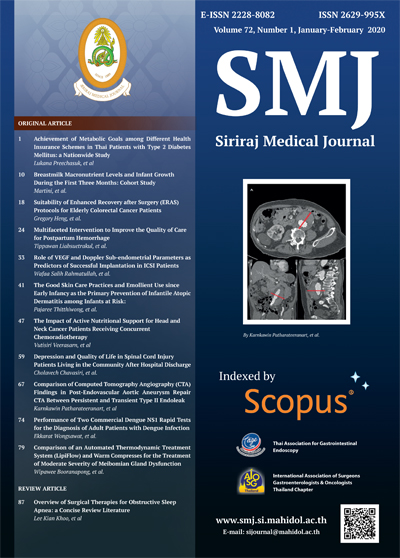The Good Skin Care Practices and Emollient Use since Early Infancy as the Primary Prevention of Infantile Atopic Dermatitis among Infants at Risk: a Randomized Controlled Trial
DOI:
https://doi.org/10.33192/Smj.2020.06Keywords:
Infantile atopic dermatitis; primary prevention; emollientAbstract
Objective: The study aimed to determine whether enhancing the skin barrier since early infancy could reduce the incidence of infantile atopic dermatitis among high risk infants.
Methods: We conducted a prospective, randomized, controlled trial at the Pediatric Clinic, Phramongkutklao Hospital in Bangkok. Eligible infants aged less than 10 weeks with family history of atopy were enrolled and randomly allocated to one of the two groups. The intervention group applied emollient at least once daily all over the body together with receiving good skin care practice advice, whereas the control group received only good skin care practice advice. All infants were followed up and assessed at 2, 4, 6 and 9 months old.
Results: Fifty-two infants were enrolled, 25 in the intervention group and 27 in the control group. At 9 months old follow-up, none in the intervention group had infantile atopic dermatitis, whereas 14.8% in the control group developed infantile atopic dermatitis (p-value < 0.05). The mean age at diagnosis of infantile atopic dermatitis was 5.5 months.
Conclusion: Regular emollient application together with good skin care practice since early infancy could reduce the incidence of infantile atopic dermatitis among high risk infants.
References
2. Vichyanond P, Sunthornchart S, Singhirannusorn V, Ruangrat S, Kaewsomboon S, Visitsunthorn N. Prevalence of asthma, allergic rhinitis and eczema among university students in Bangkok. Respir Med 2002;96:34-8.
3. Bieber T. Atopic dermatitis. Ann Dermatol 2010;22:125-37.
4. Carlsten C, Dimich-Ward H, Ferguson A, Watson W, Rousseau R, Dybuncio A, et al. Atopic dermatitis in a high-risk cohort: natural history, associated allergic outcomes, and risk factors. Ann Allergy Asthma Immunol 2013;110:24-8.
5. Spergel JM. From atopic dermatitis to asthma: the atopic march. Ann Allergy Asthma Immunol 2010;105:99-106.
6. Eichenfield LF, Tom WL, Chamlin SL, Feldman SR, Hanifin JM, Simpson EL, et al. Guidelines of care for the management of atopic dermatitis: section 1. Diagnosis and assessment of atopic dermatitis. J Am Acad Dermatol 2014;70:338-51.
7. Yaghmaie P, Koudelka CW, Simpson EL. Mental health comorbidity in patients with atopic dermatitis. J Allergy Clin Immunol 2013;131:428-33.
8. Foisy M, Boyle RJ, Chalmers JR, Simpson EL, Williams HC. Overview of Reviews The prevention of eczema in infants and children: an overview of Cochrane and non-Cochrane reviews. Evid Based Child Health 2011;6:1322-39.
9. Fleischer DM, Spergel JM, Assa'ad AH, Pongracic JA. Primary prevention of allergic disease through nutritional interventions. J Allergy Clin Immunol Pract 2013;1:29-36.
10. Oszukowska M, Michalak I, Gutfreund K, Bienias W, Matych M, Szewczyk A, et al. Role of primary and secondary prevention in atopic dermatitis. Postepy Dermatol Alergol 2015;32:409-20.
11. Ludvigsson JF, Mostrom M, Ludvigsson J, Duchen K. Exclusive breastfeeding and risk of atopic dermatitis in some 8300 infants. Pediatr Allerg Immunol 2005;16:201-8.
12. Boyle RJ, Ierodiakonou D, Khan T, Chivinge J, Robinson Z, Geoghegan N, et al. Hydrolysed formula and risk of allergic or autoimmune disease: systematic review and meta-analysis. BMJ 2016;352:i974.
13. Allen SJ, Jordan S, Storey M, Thornton CA, Gravenor MB, Garaiova I, et al. Probiotics in the prevention of eczema: a randomized controlled trial. Arch Dis Child 2014;99:1014-9.
14. Boguniewicz M, Leung DY. Atopic dermatitis: a disease of altered skin barrier and immune dysregulation. Immunol Rev 2011;242:233-46.
15. Leung DY. New insights into atopic dermatitis: role of skin barrier and immune dysregulation. Allergol Int 2013;62:151-61.
16. Simpson EL, Berry TM, Brown PA, Hanifin JM. A pilot study of emollient therapy for the primary prevention of atopic dermatitis. J Am Acad Dermatol 2010;63:587-93.
17. Simpson EL, Chalmers JR, Hanifin JM, Thomas KS, Cork MJ, McLean WH, et al. Emollient enhancement of the skin barrier from birth offers effective atopic dermatitis prevention. J Allergy Clin Immunol 2014;134:818-23.
18. Horimukai K, Morita K, Narita M, Kondo M, Kitazawa H, Nozaki M, et al. Application of moisturizer to neonates prevents development of atopic dermatitis. J Allergy Clin Immunol 2014;134:824-30.
19. Sahanavin N, Tantrakarnapa K, Prueksasit T. Ambient PM10 and PM2.5 concentrations at different high traffic related street configurations in Bangkok, Thailand. Southeast Asian J Trop Med Public Health 2016;47:528-34.
20. Dold S, Wjst M, von Mutius E, Reitmeir P, Stiepel E. Genetic risk for asthma, allergic rhinitis, and atopic dermatitis. Arch Dis Child 1992;67:1018-22.
21. Silverberg JI. Public Health Burden and Epidemiology of Atopic Dermatitis. Dermatol Clin 2017;35:283-9.
22. Adamson AS. The Economics Burden of Atopic Dermatitis. Adv Exp Med Biol 2017;1027:79-92.
Downloads
Published
How to Cite
Issue
Section
License
Authors who publish with this journal agree to the following conditions:
Copyright Transfer
In submitting a manuscript, the authors acknowledge that the work will become the copyrighted property of Siriraj Medical Journal upon publication.
License
Articles are licensed under a Creative Commons Attribution-NonCommercial-NoDerivatives 4.0 International License (CC BY-NC-ND 4.0). This license allows for the sharing of the work for non-commercial purposes with proper attribution to the authors and the journal. However, it does not permit modifications or the creation of derivative works.
Sharing and Access
Authors are encouraged to share their article on their personal or institutional websites and through other non-commercial platforms. Doing so can increase readership and citations.















